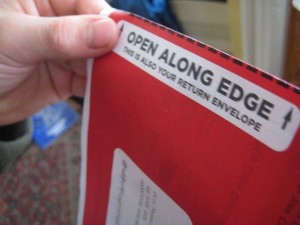2011 was a year I’m happy to be done with. So, I expect, are Netflix, Bank of America and Verizon, who saw their ill-advised attempts to insert a direct tap into their customers’ wallets flame out in 2 months, 5 weeks and 2 days respectively.
Doesn’t anybody do customer research any more? Wouldn’t it be a better idea to find out how your customers are going to react before you implement a toxic new policy? B of A and Verizon wanted to charge customers for using a debit card and paying a bill online; since those policies subsequently were reversed they’re fiscally in the same place as before but with bad press and a lot of pissed-off customers. Netflix soldiered on with its plan to separate its DVD delivery and streaming content, but paid a terrible price in subscribers and market value. How is any of this a benefit to the shareholders?
I guess it’s good news that the cycle of mea culpa is getting shorter, as noted above. But meanwhile I’ve noticed a couple of new assaults on my wallet from smaller companies and wonder if it’s part of a larger trend to put short term revenues ahead of longer term customer loyalty and common sense.
I previously wrote about Boingo and their “good news” that I could now download an updated version of their wireless roaming app that allowed me to use just two devices in my account rather than have unlimited access. I cancelled, but then I recently found myself in the BWI airport needing wireless access and was tempted by an offer to get a $25 American Express gift card after 2 months of service. So I re-upped, after discovering out something interesting: of the three different devices I was carrying, each received a different offer when I went to boingo.com. My laptop (where I’d received the email) told me I could join for $9.95 a month and made no mention of the gift card. My tablet offered the gift card and $9.95 a month. My Android had the gift card for the rate of $7.95 a month so that’s how I joined. But I don’t need a wireless service on my cell phone since it has an unlimited data plan so I went through the process of registering my laptop and tablet and was told oops, I’ve reached my 2 device limit.
Turns out the very act of signing up had registered the cell as one of my two devices and now my only option is to cancel it, effective at the end of the billing period one month hence. So I’m down to one device during this period and then can register my second device. Just way too much clunkiness for customer satisfaction and what makes it all more irritating is that Boingo has this breezy website where a message “oops… something has gone wrong” that pops up way too often and only serves to increase my irritation with that man behind the curtain.
A more disturbing revenue tactic was applied by Bill Me Later after I tried to take advantage of an offer for $15 off when I paid for an eBay transaction through their service. I was told online that, for unspecified reasons, they were unable to process my payment so fine, I paid through Paypal. I then started to get daily voicemails from somebody who left a message saying “This is the fraud department at ramamafoqw calling about a recent transaction…” They didn’t exactly say ramamafoqw but they did mumble the company name. After several calls I realized they were saying “Bill Me Later.” I called the number and got a message “we’re sorry, no one is available.” Finally their representative reached me live and it turned out the purpose of this “fraud alert” was to set up an account, but not offer me the $15 credit since that one had expired.
So that’s downright deceptive… using the fraud alert concept, which has struck terror into the heart of every consumer at one time or another, to make the customer pay attention so you can sell them a service. (And how did they get my number? Well, turns out Bill Me Later is owned by Paypal…) What this has in common with Boingo, and also the three giant companies mentioned above, is that nobody applied the sniff test. As in, “this will hopefully make us some money but is it going to make our customers more loyal and satisfied, or less?” If that question is no longer relevant, then it’s going to be a long year.
P.S. Reading over this post, my experiences do sound a bit down in the weeds and yes I do have better things to do than chasing after $25 gift cards. But these are the hooks marketers use to get customers and prospects involved, and if they don’t provide a satisfactory customer experience or are perceived as deceptive then sales will suffer and more than likely we in the marketing department will get the blame.
